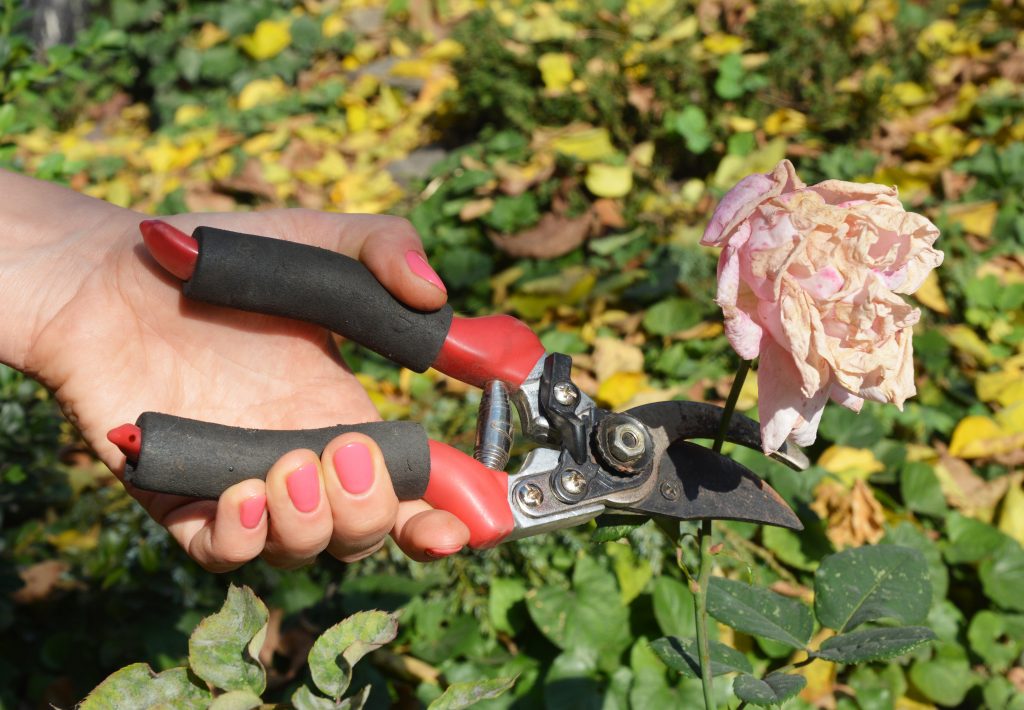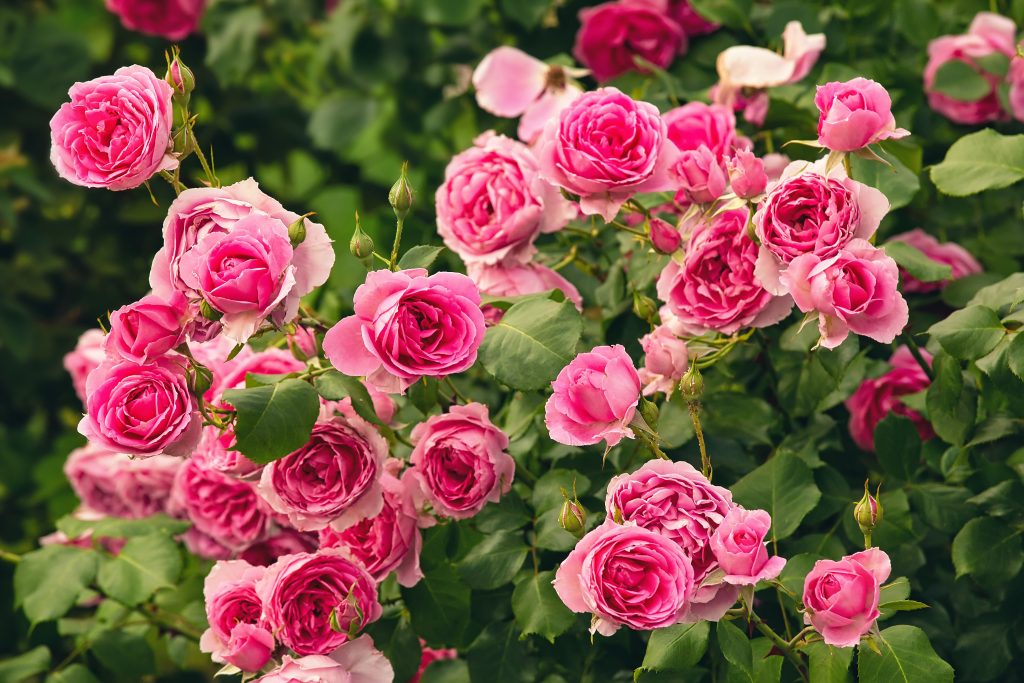Roses are known for their beauty, fragrance and stunning range of colors and types, making them one of the most enduringly popular garden and landscape plants. The genus Rosa has over 150 species spread throughout the Northern Hemisphere, including Alaska, to as far south as Mexico and North Africa. Repeat blooming roses were introduced to Europe from China in the late 18th century. They were bred with native roses for hardiness and a long blooming season, and became the basis for most modern roses.
Every year, new roses are introduced, having been bred for color, fragrance, disease resistance, ease of maintenance, or prolonged blooming. The range of choices is overwhelmingly diverse. In order to narrow down your selection, it may be helpful to become familiar with the available rose types.






Rose Classifications:
- Hybrid Tea Rose: Distinctive and singular, this is the true cutting rose with a huge, single bud held aloft on a long straight stem.
- Floribunda: Compact rounded shrub, with flower buds arranged in bunches that open to create a mass of smaller flowers.
- Grandiflora: Originally bred by crossing Hybrid Tea roses with Floribundas. The result is a plant very tall in stature with large Hybrid Tea style flowers that bloom in clusters.
- David Austin Roses: Also known as English roses. Flowers are very large, with high petal counts and usually extremely fragrant. Some varieties can climb and others are more shrub-like. Most David Austin varieties can thrive on as little as 4 hours of direct sun.
- Climbing Roses: While they are not vines, their long, rambling growth makes it easy to train them along trellises, arbors, post and fences, provided they are tied and supported along the way.
- Miniatures: Like tiny hybrid tea roses – shrubby, flowers 1-2 inches and height 18-24 inches.
- Landscape Shrub Roses: Tenacious and colorful, many selected for excellent cold hardiness and disease resistance. Most landscape roses are grown on their own roots, rather than being grafted, which makes them hardier. Many offer repeat blooms throughout the summer. They vary greatly in growth from ground cover to large shrubs, and in their soil preferences.
Site Selection
Roses typically need at least 6 hours of full sun daily. Morning sun is ideal as it dries the morning dew from the foliage, reducing disease risk. Plant at a distance from other trees and shrubs so roses will not have to compete for water and nutrients. Choose a spot protected from strong winds.
Spacing
Proper spacing depends on the variety chosen. Hybrid Tea, Grandiflora, and Floribunda do well with 2- 3 ft. between them. Larger shrub roses need more space, depending on their mature size – plan on 4-6 ft. Miniature varieties need only 1-2 ft.
Best Time to Plant
Roses, like any plant sold in containers, can be planted at any time during the season – from spring up to the early fall.
Soil
Preparing the soil is perhaps the most important step in growing roses with minimal fuss and care. Prior to planting, amend the soil with organic compost or aged manure. Adding Espoma Biotone to the mix will help promote healthy and vigorous root growth. A larger volume of organic matter may be required to loosen heavy clay soil.
Planting
Planting a container rose plant is really no different than any other container plant. Hopefully, you have amended the soil in your planting area as above! Dig a hole slightly wider than the pot. If you have not already done so, add a product containing mycorrhizae to the soil such as Espoma Biotone around the roots. If you are planting a grafted rose (most roses are grafted), make sure the bud union- the spot where the rose plant is grafted onto root stock- is buried approximately 1 inch below the soil level. This will also ensure that the crown is approximately 2 inches below the soil. When planting own root roses(non-grafted), such as landscape roses, it is not necessary to bury the crown. Back fill the hole with a combination of native soil and up to 30% organic compost. Once the rose is planted, be sure to mulch.
Watering
The deeper the rose’s roots grow, the better they can find nutrients, withstand drought and resist disease. Water deeply and slowly, 1-3 gallons for the first week or two. For the rest of the growing season, gradually increase the time between waterings, adding water when the soil several inches down feels dry; this encourages roots to grow deep. Water in the morning so that foliage dries quickly and avoid wetting foliage to avoid fungal problems. Again, keeping roses well mulched will help with moisture retention.
Feeding
Make sure you amend your soil prior to planting! Add compost and mulch yearly. Do not remove old mulch – it enriches your soil over time. In spring, when new growth is 1-2 inches long, apply a slow release, organic fertilizer, such as Espoma Rose Tone. Repeat monthly through September. There are also products on the market that combine fertilizers with insect control. If you choose to use a combination fertilizer/insecticide, read and follow all directions carefully.
Insect and Disease Management
The first step is healthy soil. Hopefully, you have amended your soil with organics when planting and have added compost and mulch yearly, as well as organic fertilizer. Healthy plants are more disease resistant! Many newer roses were bred for disease resistance but all roses can still have issues.
Roses can be susceptible to a number of fungal infections. If you suspect a fungal problem, there are many spray products on the market – treat the outbreak as it occurs. Read all directions carefully! Remove and destroy diseased leaves and canes during the growing season.
Thoroughly inspect your roses regularly for insect pests, such as aphids and Japanese beetles. It is often necessary to correctly identify the pest in order to determine the best course of action. Feel free to bring in a photo so that we may help you identify the insect and assist you in finding the proper control method. Whenever possible, physical control measures, such as spraying aphids with a strong stream of water or picking off and destroying Japanese beetles, should be used. If you determine that insecticide is needed, read all directions carefully. Spray in the early morning, not in the heat of the day.
Dead Heading
Dead heading finished flowers helps promote new growth and gives you blooms throughout the season. All cuts should be at a 45 degree angle about ¼ of an inch above a healthy leaf with FIVE leaflets. All cuts should face downward (away from the leaf pocket) so water will run off. Using the right tools will get you off to the best start. Use pruning shears with curved-edge blades or “by-pass” pruners, not the straight edged anvil type which can possibly crush the stems causing damage while they cut. Canes with jagged edges do not heal properly allowing disease and insects to get into the plants.
Many of the newer landscape roses have been bred to repeat bloom without pruning. Although they will continue to flower without pruning spent blossoms, you will see an increase in flower product when you prune the old blossoms. Stop deadheading in the fall to encourage dormancy. Once you stop deadheading, the spent blooms will form rosehips which add some fall interest to the garden.

General Pruning
Pruning gives you an annual opportunity to correct, adjust and modify the growth of your roses to increase their flower production. But in all cases, it enhances the architecture of the plant, ensures a vigorous first bloom and encourages new growth from the bud union. General heavy pruning should be done before the plant breaks dormancy after spring’s final heavy frost, typically in March or April. Most rose bushes before should be cut back 2/3 of the way except climbers and shrub roses. Climbers can be left alone or cut back up to but not more than 50% and shrub roses should be cut back no more than a 1/3rd of the outside growth. Old fashioned roses should be pruned after blooming as they bear flowers on last year’s wood. Cuts should be made at a 45 degree angle just above an outward facing bud.
Remove all dead or diseased canes by cutting flush with the bud union. Prune back any broken or injured canes below the injury. Remove any canes growing into the center of the plant that would cause a crisscrossing of branches. By removing those branches, you are allowing the plant to receive better air-circulation which reduces the chance of disease. If there are any crossing canes, choose one to prune off as chafing can create wounds that are a potential pathway to disease. Prune off canes thinner than a pencil.
Tools used for pruning roses should be disinfected with a dilute bleach solution or ethanol or isopropyl alcohol between uses, particularly if there is any suspicion of disease. Some cautious gardeners even recommend dipping the pruning blades into the disinfectant solution between each cut just to be extra careful about spreading fungal diseases.
Winterizing your Roses
There are several methods of winter protection you may choose. Make sure to mound soil or compost over the bud union, if it is exposed, keeping it warm throughout the winter months. For own root (non-grafted) roses, make sure the crown is covered with mulch for the winter. Consider mulching with straw all around the branches. Driving wind can cause a lot of damage by sucking the moisture right out of the plant. If your roses are particularly wind exposed, you may want to construct a burlap tent around, but not touching them. Commercially available pop tents are also available for plant protection.






